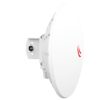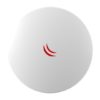مزایا
The DynaDish 5 is a new 802.11ac outdoor device with an integrated 25dBi antenna. Compact in it’s design, it is a simple and completely integrated product with everything you need to quickly install a reliable point to point link.
The DynaDish 5 is powered by a new 720MHz CPU from Qualcomm.










